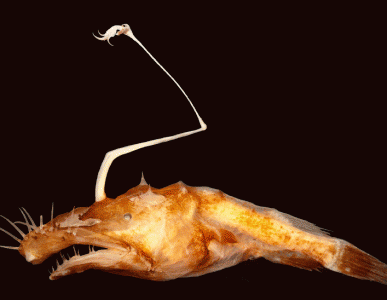NSU Newsroom
SharkBytes
Horizons
This version of NSU News has been archived as of February 28, 2019. To search through archived articles, visit nova.edu/search. To access the new version of NSU News, visit news.nova.edu.
This version of SharkBytes has been archived as of February 28, 2019. To search through archived articles, visit nova.edu/search. To access the new version of SharkBytes, visit sharkbytes.nova.edu.
New “Ugly” Deep-Sea Angler Fish Named One of Top 10 Discoveries of the Past Year
It’s the little fish that keeps on giving.
During a research trip in the Gulf of Mexico, Tracey Sutton, Ph.D., an associate professor at NSU’s Halmos College of Natural Sciences and Oceanography, made quite the discovery. Dr. Sutton, who is one of NSU’s experts on deep-sea life, found what he thought might be a new species of angler fish. After some investigation, sure enough, the odd-looking fish was, indeed, a species never before seen by humans.
After the findings were published, the new angler fish took the scientific and main stream media world by storm – being featured in hundreds of stories across the globe. And now, it has been named one of the Top 10 Discoveries of the last year by the International Institute for Species Exploration (IISE.) More than 18,000 species were reviewed, with this angler fish being honored as one of the best new finds.
“It’s really amazing how this little fish has caught the imagination of the media and fellow researchers alike,” said Dr. Sutton, who is also the Director and Primary Investigator for the Deep Pelagic Nekton Dynamics (DEEPEND) Consortium. “It’s still pretty amazing that every time we go out on a research trip, there’s a chance we’ll see something no other human has seen before.”
The Top 10 New Species list is released by the IISE each year on or about May 23, the birthday of Carolus Linnaeus, the “Father of Modern Taxonomy.” Linnaeus’s work in the 18th century began an inventory of all species and established the foundations for modern naming and classification. He is responsible for binominal nomenclature — the use of two-word names for each kind of living thing, comprised of a capitalized genus name combined with a lower case specific epithet, such as Homo sapiens — and the hierarchic classifications that categorize groups of species into genera, families, orders, classes, phyla, and kingdoms. The International Institute for Species Exploration seeks to increase awareness of the biodiversity crisis and an appreciation for the importance of taxonomy, natural history, and collections in the exploration and conservation of animals, plants and microbes.
Dr. Sutton worked with Theodore Pietsch, Ph.D. from the University of Washington to formally describe this new species of angler fish. Their findings have been published by The American Society of Ichthyologists and Herpetologists in Copeia, an international journal that publishes original research on fishes, amphibians and reptiles. You can find the full report online HERE.
This new fish, which was found between a depth of 1,000-1,500 meters, is a new species of ceratioid anglerfish (Genus Lasiognathus Regan [Lophiiformes: Oneirodidae]). The three female specimens found ranged in size from 30-95 mm in length. These specimens are considered “type specimens” (i.e. they define the species,) and as such, Dr. Sutton said that they will reside in the Ichthyology Collection at the University of Washington, which is home to the world’s largest deep-sea anglerfish collection.
Dr. Sutton studies the ecology of marine systems, particularly those of the open ocean. As part of those efforts, he is leading a team of scientists and researchers studying the effects of oil spills on deep-sea marine life. That project recently received a boost, thanks to a financial award from the Gulf of Mexico Research Initiative (GoMRI.) NSU was awarded $8.5 million and is one of 12 organizations selected to receive part of $140 million for continued research in the area of oil spills and how we respond to them.
Along with his work at NSU, Dr. Sutton is also a steering committee member of the Deep Ocean Stewardship Initiative, a co-principal investigator in the Global Ocean Biodiversity Initiative, an expert panelist in the United Nations First Ocean Assessment, an affiliate scientist of the Monterey Bay Aquarium Research Institute, and adjunct faculty of the Ocean Research and Conservation Association.
